
Wine Culture and Information since 2002 - Volume 22
 Wine Culture and Information since 2002 - Volume 22 |
|
Issue 184, May 2019 |
Contents |
|
|
The War of Closures |
|
The keeping and transport of wine is a need evidently born with the discovery of the beverage of Bacchus. Since ancient times, and of which we have written proofs from the authors of the past, whoever produced wine had the need to keep it over time and, above all, to transport it in order to get a commercial profit. Wine has been in fact an important trade commodity, literally traveling around the world, crossing countries and oceans. A problem that is not trivial, of course, and widely proven by the many solutions man adopted in the course of history with the aim of both keeping wine over time and the possibility of transporting it. In this regard, it must be noticed the wooden barrel – a tool now confined inside wineries only – was invented in order to easily transport huge quantities of wine and to make it reach very distant destinations. The sealing of containers used for keeping wine has always been a crucial and delicate aspect, with the aim of implementing efficient measures in order to avoid contact with oxygen and light. Since the time of amphorae and terracotta vessels, there have been adopted many solutions, often unique and not always effective. The introduction of the glass bottle – in the beginning quite different from the one we are used today – has in some respects made things even complicated, at least until the cork has been used for making closures. The association of bottle and cork is so strongly rooted today that for many it remains the only acceptable and traditional solution, therefore indissoluble. Cork stoppers, despite their centuries-old reputation in sealing wine bottles, do not always effectively fulfill the purpose of keeping. It is in fact enough to mention the feared cork taint, so unpleasant and devastating, capable of irreparably spoiling any wine. The dreaded 2,4,6-trichloroanisole – the substance responsible for the annoying fault, simply called trichloroanisole or, in short, TCA – is the risk that you run by using cork stoppers. It is a substance produced by the Armillaria Mellea, a parasitic fungus of the cork oak that produces trichloroanisole as a by-product of its metabolism. It is difficult to describe, exactly and by analogy, the smell of this fault, however, once it is perceived, it is hardly forgotten and become both unpleasant and easily recognizable in a wine. The smell of a faulty cork – also known as cork taint – may reminds the one of certain molds, a description that is however incomplete because it is a decidedly more complex sensation. Wet cardboard, wet newspaper, wet dog and dirty cellar are just some of the descriptive terms used to define the cork taint, indeed in a completely incomplete and approximate way. It should however be noted the incidence of cork taint has definitely decreased over the last recent years, thanks to more rigorous checks on quality and health of cork. In the past, however, uncorking a bottle and having under the nose a wine spoiled by the trichloroanisole was something quite likely to happen, with consequent economic loss for both consumers and producers. The cork evidently offers however extraordinary characteristics for the sealing of a bottle and, therefore, the keeping of wine. First of all, elasticity, capable to adapt to the neck of the bottle in order to ensure optimal sealing for several years. No less important, the characteristic that could represent a paradox, that is the ability to allow the precious oxidation of the wine and letting it to age and, possibly, improving over time. It is, of course, very small amounts of oxygen which, by passing through the tiny pores of the cork, reach the inside of the bottle. However, cork, with all of its pros and cons, is not the ultimate and convenient solution. Not all cork stoppers are of high quality and those having it, also have a high cost and significantly affecting the final price of wine. High quality cork stoppers are in fact used in wines intended for long aging in bottle and which are generally sold at a high price. This choice, in fact, in addition to ensuring a better keeping over time – thus allowing the wine to age and evolve profitably – undergo specific treatments usually lowering the risk of trichloroanisole contamination. In the last twenty years, many alternatives closures to cork have been proposed, both to limit the incidence of costs and the effects of the so-called cork taint. Of the many solutions proposed, we can certainly recall the so called “synthetic corks” – including those with valves allowing the calibrated passage of oxygen – glass, screw and crown caps. Of these alternative solutions, today it is the screw cap to get the highest appreciation from producers. It was not a simple achievement, mainly due to the prejudice of consumers, so strongly fond of the traditional cork and tending to consider every alternative solution as offensive. It must be said that, for wines destined to a long aging in bottle, quality cork remains in any case the primary choice as well as indispensable. For wines meant to be consumed in their youth or in any case within a few years from harvesting, screw cap certainly is an excellent solution. Not only does it avoid the annoying cork taint – and therefore the subsequent economic loss – but its capability to keep a wine both intact and fresh, ideal for young wines, is now widely proven. I have never had any prejudices or negative attitudes towards the so-called alternative corks and I have always welcomed bottles sealed with screw caps. Convenient, practical, easy to open, it gives our senses an intact and unspoiled wine, with the certainty of avoiding the disappointment and the risk of finding the unpleasant cork taint in your glass. Cork certainly is fascinating, but it is not always the best solution to keep wine, or at least, not all wines. It is nice to see that finally, after years of prejudices and cultural obstacles, alternative solutions – screw cap above all – are gradually spreading. After all, wine is all that matters as well as having it in your glass enjoyable and intact in its qualities, both in its youth and when kissed by the wisdom of time. Antonello Biancalana
|
||||
Contrasts of Fiano di Avellino and Greco di TufoThe two great protagonists of Campania's white wines compared in the glasses of this month's tasting by contrast |
|
When we talk about the enology of Campania and its wines, the first ones coming to mind are clearly whites and, in particular, two made in the territory of Irpinia: Fiano di Avellino and Greco di Tufo. These are in fact the wines that, in relatively recent times, have given new impetus and notoriety to Campania wine making, reviving the interest in this region's wines both in Italy and in the world. Of course, these are not the only wines capable of worthily representing Campania, they can however be considered the main responsible for the enological revival of the region. Campania boasts a long and glorious wine history, widely testified by the numerous authors of the past who praised and emphasized the quality of the wines produced in this region. The wealth of wines and grapes of Campania, in fact, is well represented by white and red varieties, which have proven undeniable greatness through their wines. Fiano and Greco, however, can be considered the most famous and celebrated white grape varieties of the region, a success started in the territory of Irpinia, widely confirmed also in the other territories of Campania. These two varieties, in fact, are widely common all over the region, always becoming interpreters of personality in all the wines they are produced with. In this regard, in fact, we can consider the considerable differences, for example, between wines produced with Fiano in the territory of Irpinia and those made in Cilento: same grape, different wines, sometimes even distant. The same can be said for Greco by comparing the different enological expressions produced in Campania. The difference, of course, is determined by the composition of the soil, by climatic conditions and, not least, by the interpretation of the producers. This is definitely significant for Irpinia and Cilento, territories characterized by completely different soils and climatic conditions but in which Fiano is always capable of expressing wines of primary magnificence.
|
|
Fiano di Avellino is one of the four Denominazione d'Origine Controllata e Garantita wines of Campania (Denomination of Controlled and Guaranteed Origin, DOCG), a ranking achieved in 2003. It is undoubtedly one of the most significant white wines of Campania and Italy, mainly produced with the homonymous grape, a variety present in these lands since time immemorial and introduced here by the ancient Greeks. The first vines of Vitis Apicia – this is how in ancient times was called Fiano – were planted in the territory of Lapio, a town not so far from Avellino, still today among the most significant production areas of Fiano di Avellino. The name of this place, in fact, is believed to come from the Apicia grape which, with the course of time, becomes Apina, then Apiana, therefore Afiana and finally Fiano. The original name of the grape probably comes from the particular predilection bees have for the nectar of this variety and from which – it seems – they were irresistibly attracted. The history and quality of Fiano have been known since ancient times, making it one of the most appreciated grapes of the past, so much so that it was planted in most of south Italy, sought after for the finesse and elegance of its wines. In the territory of Avellino, Fiano has established deep and solid roots, so much so that it has become the enological reference for wines produced with this variety. The fame and notoriety of Fiano produced in Avellino and, in particular, in Lapio, reached levels of considerable commercial importance, reaching a production of several million liters in the past centuries. Fiano thus became an important economic commodity in these lands, requiring the construction of a special railway line in order to facilitate the transport of wine. The flourishing trade of Fiano di Avellino was suddenly interrupted due to the advent of the phylloxera which, here as elsewhere, decimated the vineyards therefore reducing the produced quantity. The relaunch of Fiano di Avellino began in the 1970s, greatly expanding the area dedicated to its cultivation – together with the adoption of better breeding techniques – achieving important results in terms of quality, up to reaching DOCG status in 2003.
|
||||
|
In the province of Avellino and not far from Lapio, is located Tufo, a town that has associated its name to the famous white wine produced with Greco grape. Consecrated to the Denominazione d'Origine Controllata e Garantita status in 2003, together with Fiano di Avellino, Greco di Tufo also contributed significantly to the relaunch of Campania's quality wine making. Greco, just like Fiano, is a variety introduced in Campania by the ancient Greeks in the first century BC. The quality and prestige of the wines produced with Greco grapes has been known since the times of its introduction and there are numerous praises and mentions from the authors of the past, in particular, Pliny the Elder. In fact, in this regard, this famous author wrote “in truth Greco wine was so precious that it was poured only once in banquets”. The prestige and fame of wines produced with Greco are also praised by Virgil, Cato, Columella and Varro. Greco grape, just like Fiano, is a common variety in Campania – while noticing in ancient times it was particularly cultivated and appreciated in the territory of Vesuvius – however today it is the expression of Tufo wines to mainly represent this grape. Variety capable of creating wines of excellent quality and good potential for aging over time, Greco is today present in many Italian regions, particularly in those of the south. However, Campania remains the most significant region for the production of wines from this variety, also proving interesting versatility even in the production of classic method sparkling wines, a style included – among other ones – in the production disciplinary of Greco di Tufo. This variety is also suited for the aging in wood, however producers tend to favor the use of inert containers – such as stainless steel – in order to better preserve the olfactory and gustatory expression of the wines.
|
The wines of the tasting by contrast of this month represent, as already mentioned, two of the main denominations of Campania: Fiano di Avellino and Greco di Tufo. Both wines, since 2003, have the ranking of Denominazione d'Origine Controllata e Garantita (Controlled and Guaranteed Denomination of Origin, DOCG) the highest level allowed by the Italian quality system. In choosing the two wines, however, we will pay attention to their composition, as – in both cases – the respective production disciplinary provide for a minimum 85% of the main varieties, Fiano and Greco, thus admitting the presence of other grapes. We will therefore make sure the wines are produced with their respective varieties alone, a wine making choice that – it must be said – is increasingly common among the producers of these territories. As for the enological practices, we will also make sure both wines of our tasting are exclusively fermented and aged in inert containers, in order to ensure the best varietal expression of the grapes. The wines, belonging to the latest commercialized vintage, are served in tasting glasses at a temperature of 10 °C. (50 °F) Let's pour the two wines in their respective glasses and begin the tasting by contrast of this month by proceeding with the evaluation of the appearance of Fiano di Avellino. By tilting the glass over a white surface and, looking at the base of the wine, let's evaluate color and transparency. The wine has a pale straw yellow color and a high transparency, so much so that it is clearly possible to see the object placed between the glass and the white surface. The nuance of Fiano di Avellino, observed at the edge of the wine, towards the opening of the glass, reveals a greenish yellow hue, also confirming its young age. Let's now pass to the evaluation of Greco di Tufo's appearance, also in this case by tilting the glass over the white surface. The color of the wine, observed at the base of the glass, reveals an intense straw yellow hue, sometimes tending to golden yellow, with a very high transparency. The nuance of Greco di Tufo, observed at the edge of the wine, shows a straw yellow color tending to greenish yellow. Wines produced with Fiano and Greco give to the nose sensations of refined elegance, with common aromatic qualities although characterized by profound differences in terms of composition and development. Both grapes have widely proven their ability to make wines with excellent aging potential, developing interesting complexity and evolution over time. Fiano and Greco are both characterized by sensations of white and yellow pulp fruit, as well as aromas that directly remind flowers. These two varieties are also characterized by certain aromas reminiscent of dried fruits: hazelnut typically associated with Fiano, almond more common in wines produced with Greco. Very often, both in Fiano di Avellino and Greco di Tufo, are perceived aromas recalling exotic fruits as well as pleasing sensations reminiscent of aromatic herbs typical of the Mediterranean scrub. Let's continue our tasting by contrast and concentrate on the evaluation of the olfactory profiles of Fiano di Avellino and Greco di Tufo, starting from the first wine. By holding the glass in vertical position and without swirling, we perform the first smell that will allow the evaluation of the opening, that is the first identifying aromas developing from the glass. Fiano di Avellino opens with aromas of apple, pear and hawthorn followed by the characteristic hazelnut aroma. Let's swirl the glass – operation favoring the development of the other aromas – and perform the second smell. The olfactory profile of Fiano di Avellino is completed with plum, peach, pineapple, broom, citrus fruits, medlar as well as aromas of aromatic herbs such as rosemary and linden. Let's now pass to the evaluation of Greco di Tufo's opening, by performing the first smell and keeping the glass in vertical position, without swirling. This wine reveals to the nose aromas of pear, quince and peach, followed by the characteristic almond scent. After having swirled the glass, the olfactory profile of Greco di Tufo is completed with plum, pineapple, hawthorn, broom, apricot, followed by hints recalling fennel and linden. It is now the time to evaluate the gustatory profiles of the wines of this month and, as in the previous phases, we start from Fiano di Avellino. Let's take a sip of this wine and proceed with the evaluation of the attack, that is the first sensations perceived in the mouth. The wine reveals a clear and pleasing sensation of crispness given by acidity, followed by the pseudo-burning effect of alcohol allowing the wine to reach its balance. In the mouth is perceived an appreciable structure, while expressing excellent agreeableness in which can be perceived flavors of apple, pear and pineapple, confirming a good correspondence to the nose. Let's now pass to Greco di Tufo and take a sip of this wine in order to evaluate its attack. The second wine of our tasting by contrast reveals in the mouth a pleasant crispness and, also in this case, the contribution of alcohol is fundamental for balance, to which contributes a more intense roundness than Fiano. In the mouth, in addition to the perception of the evident structure, we perceive the flavors of pear, quince and peach, confirming the good correspondence to the nose. The last phase of our tasting will examine the final qualities of the organoleptic perception, that is the sensations the wine leaves in the mouth after swallowing, in particular, the taste-olfactory persistence, one of the primary factors determining quality. The finish of Fiano di Avellino is persistent, leaving in the mouth a pleasant sensation of crispness – therefore of acidity – in addition to the good structure typical in wines produced with this grape. The flavors of apple, pear and pineapple can be still perceived, followed by the characteristic flavor reminiscent of hazelnut. The finish of Greco di Tufo is persistent and, like the previous wine, it leaves in the mouth the pleasant sensation of acidity combined with a good roundness and structure. We can clearly perceive flavors of pear, quince and peach as well as the pleasant slightly bitter sensation of almond. Finally, let's evaluate in sequence the olfactory and gustatory profile of both wines, Fiano di Avellino first and then Greco di Tufo: the differences are evident both in the nose and in the mouth.
|
||||||||
Wines of the Month |
|
|
|
Score legend Prices are to be considered as indicative. Prices may vary according to the country or the shop where wines are bought |
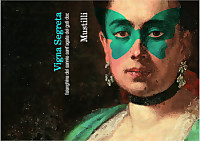
|
|
Sannio Sant'Agata dei Goti Falanghina Vigna Segreta 2016 |
|
| Mustilli (Campania, Italy) | |
 Falanghina Falanghina | |
| Price: € 18.00 | Score: |
 Brilliant straw yellow and nuances of straw yellow, very transparent. Brilliant straw yellow and nuances of straw yellow, very transparent. Intense, clean, pleasing and refined, starts with hints of plum, medlar
and citrus fruits followed by aromas of apple, pear, pineapple, broom,
hawthorn, peach and mineral. Intense, clean, pleasing and refined, starts with hints of plum, medlar
and citrus fruits followed by aromas of apple, pear, pineapple, broom,
hawthorn, peach and mineral.
 Crisp attack and however balanced by alcohol, good body, intense
flavors, agreeable. Crisp attack and however balanced by alcohol, good body, intense
flavors, agreeable.
 Persistent finish with flavors of plum, medlar and apple. Persistent finish with flavors of plum, medlar and apple. 10 months in steel tanks, 3 months in bottle. 10 months in steel tanks, 3 months in bottle. |
|
 Pasta with fish, Fried fish, Sauteed white meat, Sauteed fish with mushrooms, Dairy products Pasta with fish, Fried fish, Sauteed white meat, Sauteed fish with mushrooms, Dairy products |
|

|
|
Sannio Sant'Agata dei Goti Piedirosso Artus 2016 |
|
| Mustilli (Campania, Italy) | |
 Piedirosso Piedirosso | |
| Price: € 18.00 | Score: |
 Brilliant ruby red and nuances of garnet red, moderate transparency. Brilliant ruby red and nuances of garnet red, moderate transparency. Intense, clean, pleasing and refined, starts with hints of cherry, plum
and raspberry followed by aromas of dried violet, blueberry, flint, carob,
thyme, black pepper and menthol. Intense, clean, pleasing and refined, starts with hints of cherry, plum
and raspberry followed by aromas of dried violet, blueberry, flint, carob,
thyme, black pepper and menthol.
 Properly tannic attack and however balanced by alcohol, good body,
intense flavors, pleasing crispness. Properly tannic attack and however balanced by alcohol, good body,
intense flavors, pleasing crispness.
 Persistent finish with flavors of cherry, plum and raspberry. Persistent finish with flavors of cherry, plum and raspberry. 12 months in amphora, 6 months in bottle. 12 months in amphora, 6 months in bottle. |
|
 Fish soups, Stuffed pasta with meat, Cold cuts, Sauteed meat Fish soups, Stuffed pasta with meat, Cold cuts, Sauteed meat |
|
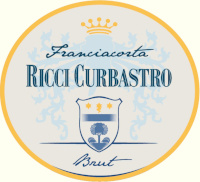
|
|
Franciacorta Brut |
|
| Ricci Curbastro (Lombardy, Italy) | |
 Chardonnay (60%), Pinot Bianco (30%), Pinot Nero (10%) Chardonnay (60%), Pinot Bianco (30%), Pinot Nero (10%) | |
| Price: € 20.00 | Score: |
 Pale straw yellow and nuances of greenish yellow, very transparent,
fine and persistent perlage. Pale straw yellow and nuances of greenish yellow, very transparent,
fine and persistent perlage.
 Intense, clean, pleasing and refined, starts with hints of apple,
citrus fruits and bread crust followed by aromas of banana, pear, yeast,
pineapple and plum. Intense, clean, pleasing and refined, starts with hints of apple,
citrus fruits and bread crust followed by aromas of banana, pear, yeast,
pineapple and plum.
 Effervescent and crisp attack, however balanced by alcohol, good body,
intense flavors, agreeable. Effervescent and crisp attack, however balanced by alcohol, good body,
intense flavors, agreeable.
 Persistent finish with flavors of apple, banana and plum. Persistent finish with flavors of apple, banana and plum. Refermented in bottle on its lees for 30 months. Refermented in bottle on its lees for 30 months. |
|
 Fish appetizers, Pasta and risotto with crustaceans, Sauteed fish, Dairy products Fish appetizers, Pasta and risotto with crustaceans, Sauteed fish, Dairy products |
|
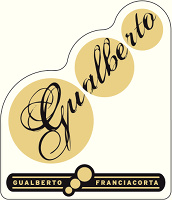
|
|
Franciacorta Dosaggio Zero Gualberto 2009 |
|
| Ricci Curbastro (Lombardy, Italy) | |
 Pinot Nero (65%), Chardonnay (35%) Pinot Nero (65%), Chardonnay (35%) | |
| Price: € 40.00 | Score: |
 Brilliant golden yellow and nuances of golden yellow, very transparent,
fine and persistent perlage. Brilliant golden yellow and nuances of golden yellow, very transparent,
fine and persistent perlage.
 Intense, clean, pleasing, refined and elegant, starts with hints of
apple, bread crust and plum followed by aromas of grapefruit, tangerine,
hazelnut, brioche, butter, yeast, almond, honey and hints of vanilla. Intense, clean, pleasing, refined and elegant, starts with hints of
apple, bread crust and plum followed by aromas of grapefruit, tangerine,
hazelnut, brioche, butter, yeast, almond, honey and hints of vanilla.
 Crisp and effervescent attack, however balanced by alcohol, good body,
intense flavors, agreeable. Crisp and effervescent attack, however balanced by alcohol, good body,
intense flavors, agreeable.
 Very persistent finish with long flavors of apple, plum and hazelnut. Very persistent finish with long flavors of apple, plum and hazelnut. Part of the base wine ferments in cask. Refermented in bottle on its
lees for 60 months. Part of the base wine ferments in cask. Refermented in bottle on its
lees for 60 months.
|
|
 Pasta with fish and mushrooms, Roasted fish, Roasted white meat, Stewed fish Pasta with fish and mushrooms, Roasted fish, Roasted white meat, Stewed fish |
|

|
|
Pietra Susumaniello 2017 |
|
| Menhir (Apulia, Italy) | |
 Susumaniello Susumaniello | |
| Price: € 12.00 | Score: |
 Intense ruby red and nuances of ruby red, little transparency. Intense ruby red and nuances of ruby red, little transparency. Intense, clean, pleasing and refined, starts with hints of black
cherry, black currant and plum followed by aromas of raspberry, violet,
blueberry, coriander and black pepper. Intense, clean, pleasing and refined, starts with hints of black
cherry, black currant and plum followed by aromas of raspberry, violet,
blueberry, coriander and black pepper.
 Properly tannic attack and however balanced by alcohol, good body,
intense flavors, pleasing crispness. Properly tannic attack and however balanced by alcohol, good body,
intense flavors, pleasing crispness.
 Persistent finish with flavors of black cherry, black currant and plum. Persistent finish with flavors of black cherry, black currant and plum. 6 months in steel tanks. 6 months in steel tanks. |
|
 Pasta con carne, Carne alla griglia, Stufati di carne con funghi Pasta con carne, Carne alla griglia, Stufati di carne con funghi |
|
|
|
|
CalaMuri 2015 |
|
| Menhir (Apulia, Italy) | |
 Primitivo Primitivo | |
| Price: € 15.00 | Score: |
 Intense ruby red and nuances of garnet red, little transparency. Intense ruby red and nuances of garnet red, little transparency. Intense, clean, pleasing, refined and elegant, starts with hints of
plum, blackberry and dried violet followed by aromas of black cherry,
blueberry, carob, tobacco, chocolate, vanilla, licorice, leather and
menthol. Intense, clean, pleasing, refined and elegant, starts with hints of
plum, blackberry and dried violet followed by aromas of black cherry,
blueberry, carob, tobacco, chocolate, vanilla, licorice, leather and
menthol.
 Properly tannic attack and however balanced by alcohol, full body,
intense flavors, pleasing roundness. Properly tannic attack and however balanced by alcohol, full body,
intense flavors, pleasing roundness.
 Persistent finish with flavors of plum, blackberry and black cherry. Persistent finish with flavors of plum, blackberry and black cherry. 12 months in barrique. 12 months in barrique. |
|
 Game, Stewed and braised meat, Roasted meat, Hard cheese Game, Stewed and braised meat, Roasted meat, Hard cheese |
|
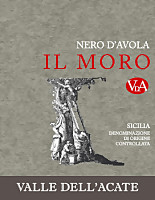
|
|
Il Moro 2015 |
|
| Valle dell'Acate (Sicily, Italy) | |
 Nero d'Avola Nero d'Avola | |
| Price: € 16.50 | Score: |
 Brilliant ruby red and nuances of ruby red, moderate transparency. Brilliant ruby red and nuances of ruby red, moderate transparency. Intense, clean, pleasing and refined, starts with hints of plum, black
cherry and blackberry followed by aromas of violet, raspberry, blueberry,
carob, tobacco, cinnamon, vanilla and menthol. Intense, clean, pleasing and refined, starts with hints of plum, black
cherry and blackberry followed by aromas of violet, raspberry, blueberry,
carob, tobacco, cinnamon, vanilla and menthol.
 Properly tannic attack and however balanced by alcohol, good body,
intense flavors, pleasing roundness. Properly tannic attack and however balanced by alcohol, good body,
intense flavors, pleasing roundness.
 Persistent finish with flavors of plum, black cherry and blackberry. Persistent finish with flavors of plum, black cherry and blackberry. 12 months in steel tanks and cask. 12 months in steel tanks and cask. |
|
 Broiled meat and barbecue, Sauteed meat with mushrooms, Stuffed pasta, Hard cheese Broiled meat and barbecue, Sauteed meat with mushrooms, Stuffed pasta, Hard cheese |
|
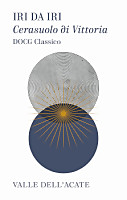
|
|
Cerasuolo di Vittoria Classico Iri da Iri 2013 |
|
| Valle dell'Acate (Sicily, Italy) | |
 Nero d'Avola (60%), Frappato (40%) Nero d'Avola (60%), Frappato (40%) | |
| Price: € 50.00 | Score: |
 Brilliant ruby red and nuances of garnet red, moderate transparency. Brilliant ruby red and nuances of garnet red, moderate transparency. Intense, clean, pleasing, refined and elegant, starts with hints of
plum, blackberry and black cherry followed by aromas of dried violet,
blueberry, cocoa, tobacco, cinnamon, graphite, licorice, leather, mace,
vanilla and menthol. Intense, clean, pleasing, refined and elegant, starts with hints of
plum, blackberry and black cherry followed by aromas of dried violet,
blueberry, cocoa, tobacco, cinnamon, graphite, licorice, leather, mace,
vanilla and menthol.
 Properly tannic attack and however balanced by alcohol, good body,
intense flavors, agreeable. Properly tannic attack and however balanced by alcohol, good body,
intense flavors, agreeable.
 Persistent finish with flavors of plum, blackberry and black cherry. Persistent finish with flavors of plum, blackberry and black cherry. 36 months in cask, 18 months in bottle. 36 months in cask, 18 months in bottle. |
|
 Broiled meat and barbecue, Roasted meat, Stewed meat with mushrooms, Hard cheese Broiled meat and barbecue, Roasted meat, Stewed meat with mushrooms, Hard cheese |
|
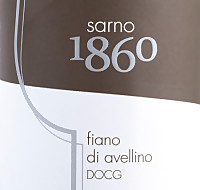
|
|
Fiano di Avellino 2017 |
|
| Tenuta Sarno 1860 (Campania, Italy) | |
 Fiano Fiano | |
| Price: € 19.00 | Score: |
 Pale straw yellow and nuances of greenish yellow, very transparent. Pale straw yellow and nuances of greenish yellow, very transparent. Intense, clean, pleasing, refined and elegant, starts with hints of
pear, pineapple and hazelnut followed by aromas of peach, apple, broom,
hawthorn, citron, melon, plum, linden and mineral. Intense, clean, pleasing, refined and elegant, starts with hints of
pear, pineapple and hazelnut followed by aromas of peach, apple, broom,
hawthorn, citron, melon, plum, linden and mineral.
 Crisp attack and however balanced by alcohol, good body, intense
flavors, agreeable. Crisp attack and however balanced by alcohol, good body, intense
flavors, agreeable.
 Persistent finish with flavors of pear, pineapple and peach. Persistent finish with flavors of pear, pineapple and peach. 8 months in steel tanks, 6 months in bottle. 8 months in steel tanks, 6 months in bottle. |
|
 Risotto and pasta with crustaceans, Fried fish, Dairy products, Sauteed fish, Sauteed white meat Risotto and pasta with crustaceans, Fried fish, Dairy products, Sauteed fish, Sauteed white meat |
|
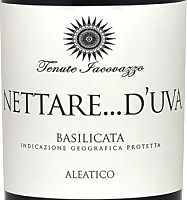
|
|
Nettare d'Uva 2016 |
|
| Tenute Iacovazzo (Basilicata, Italy) | |
 Aleatico Aleatico | |
| Price: € 18.00 | Score: |
 Brilliant ruby red and nuances of garnet red, moderate transparency. Brilliant ruby red and nuances of garnet red, moderate transparency. Intense, clean, pleasing and refined, starts with hints of cherry, plum
and raspberry followed by aromas of violet, rose, strawberry, cyclamen,
blueberry and blackberry. Intense, clean, pleasing and refined, starts with hints of cherry, plum
and raspberry followed by aromas of violet, rose, strawberry, cyclamen,
blueberry and blackberry.
 Properly tannic attack with a hint of sweetness, however balanced by
alcohol, good body, intense flavors, pleasing crispness. Properly tannic attack with a hint of sweetness, however balanced by
alcohol, good body, intense flavors, pleasing crispness.
 Persistent finish with flavors of cherry, plum and raspberry. Persistent finish with flavors of cherry, plum and raspberry. Aged in steel tanks. Aged in steel tanks. |
|
 Confectionery, Fruit tarts Confectionery, Fruit tarts |
|
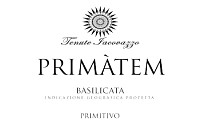
|
|
Primatem 2016 |
|
| Tenute Iacovazzo (Basilicata, Italy) | |
 Primitivo Primitivo | |
| Price: € 15.00 | Score: |
 Brilliant ruby red and nuances of garnet red, little transparency. Brilliant ruby red and nuances of garnet red, little transparency. Intense, clean, pleasing and refined, starts with hints of black
cherry, blackberry and plum followed by aromas of dried violet, blueberry,
carob, mace, tobacco and menthol. Intense, clean, pleasing and refined, starts with hints of black
cherry, blackberry and plum followed by aromas of dried violet, blueberry,
carob, mace, tobacco and menthol.
 Properly tannic attack and however balanced by alcohol, good body,
intense flavors, pleasing roundness. Properly tannic attack and however balanced by alcohol, good body,
intense flavors, pleasing roundness.
 Persistent finish with flavors of black cherry, plum and blackberry. Persistent finish with flavors of black cherry, plum and blackberry. Aged in steel tanks and barrique. Aged in steel tanks and barrique. |
|
 Stuffed pasta with meat, Broiled meat and barbecue, Stewed meat with mushrooms Stuffed pasta with meat, Broiled meat and barbecue, Stewed meat with mushrooms |
|
News |
|
In this section are published news and information about events concerning the world of wine and food. Whoever is interested in publishing this kind of information can send us a mail to our address.
|
AquavitaeReview of Grappa, Distillates and Brandy |
|
|
||||||||||||
Wine Guide ParadeFebruary 2019
|
| |||||||
Privacy Policy | |||||||


| Copyright © 2002-2024 Antonello Biancalana, DiWineTaste - All rights reserved |
| All rights reserved under international copyright conventions. No part of this publication and of this WEB site may be
reproduced or utilized in any form or by any means, electronic or mechanical, without permission in writing from DiWineTaste. |